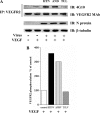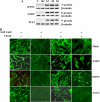Pathogenic hantaviruses Andes virus and Hantaan virus induce adherens junction disassembly by directing vascular endothelial cadherin internalization in human endothelial cells
- PMID: 20463083
- PMCID: PMC2898267
- DOI: 10.1128/JVI.00576-10
Pathogenic hantaviruses Andes virus and Hantaan virus induce adherens junction disassembly by directing vascular endothelial cadherin internalization in human endothelial cells
Abstract
Hantaviruses infect endothelial cells and cause 2 vascular permeability-based diseases. Pathogenic hantaviruses enhance the permeability of endothelial cells in response to vascular endothelial growth factor (VEGF). However, the mechanism by which hantaviruses hyperpermeabilize endothelial cells has not been defined. The paracellular permeability of endothelial cells is uniquely determined by the homophilic assembly of vascular endothelial cadherin (VE-cadherin) within adherens junctions, which is regulated by VEGF receptor-2 (VEGFR2) responses. Here, we investigated VEGFR2 phosphorylation and the internalization of VE-cadherin within endothelial cells infected by pathogenic Andes virus (ANDV) and Hantaan virus (HTNV) and nonpathogenic Tula virus (TULV) hantaviruses. We found that VEGF addition to ANDV- and HTNV-infected endothelial cells results in the hyperphosphorylation of VEGFR2, while TULV infection failed to increase VEGFR2 phosphorylation. Concomitant with the VEGFR2 hyperphosphorylation, VE-cadherin was internalized to intracellular vesicles within ANDV- or HTNV-, but not TULV-, infected endothelial cells. Addition of angiopoietin-1 (Ang-1) or sphingosine-1-phosphate (S1P) to ANDV- or HTNV-infected cells blocked VE-cadherin internalization in response to VEGF. These findings are consistent with the ability of Ang-1 and S1P to inhibit hantavirus-induced endothelial cell permeability. Our results suggest that pathogenic hantaviruses disrupt fluid barrier properties of endothelial cell adherens junctions by enhancing VEGFR2-VE-cadherin pathway responses which increase paracellular permeability. These results provide a pathway-specific mechanism for the enhanced permeability of hantavirus-infected endothelial cells and suggest that stabilizing VE-cadherin within adherens junctions is a primary target for regulating endothelial cell permeability during pathogenic hantavirus infection.
Figures




Similar articles
-
Hantaviruses direct endothelial cell permeability by sensitizing cells to the vascular permeability factor VEGF, while angiopoietin 1 and sphingosine 1-phosphate inhibit hantavirus-directed permeability.J Virol. 2008 Jun;82(12):5797-806. doi: 10.1128/JVI.02397-07. Epub 2008 Mar 26. J Virol. 2008. PMID: 18367532 Free PMC article.
-
Andes virus regulation of cellular microRNAs contributes to hantavirus-induced endothelial cell permeability.J Virol. 2010 Nov;84(22):11929-36. doi: 10.1128/JVI.01658-10. Epub 2010 Sep 15. J Virol. 2010. PMID: 20844033 Free PMC article.
-
VEGFR2 and Src kinase inhibitors suppress Andes virus-induced endothelial cell permeability.J Virol. 2011 Mar;85(5):2296-303. doi: 10.1128/JVI.02319-10. Epub 2010 Dec 22. J Virol. 2011. PMID: 21177802 Free PMC article.
-
Dynamic Regulation of Vascular Permeability by Vascular Endothelial Cadherin-Mediated Endothelial Cell-Cell Junctions.J Nippon Med Sch. 2017;84(4):148-159. doi: 10.1272/jnms.84.148. J Nippon Med Sch. 2017. PMID: 28978894 Review.
-
Dialogue between VE-Cadherin and Sphingosine 1 Phosphate Receptor1 (S1PR1) for Protecting Endothelial Functions.Int J Mol Sci. 2023 Feb 16;24(4):4018. doi: 10.3390/ijms24044018. Int J Mol Sci. 2023. PMID: 36835432 Free PMC article. Review.
Cited by
-
Host mTORC1 signaling regulates andes virus replication.J Virol. 2013 Jan;87(2):912-22. doi: 10.1128/JVI.02415-12. Epub 2012 Nov 7. J Virol. 2013. PMID: 23135723 Free PMC article.
-
Virus interactions with endothelial cell receptors: implications for viral pathogenesis.Curr Opin Virol. 2014 Aug;7:134-40. doi: 10.1016/j.coviro.2014.06.006. Epub 2014 Jul 24. Curr Opin Virol. 2014. PMID: 25063986 Free PMC article. Review.
-
The Syrian hamster model of hantavirus pulmonary syndrome.Antiviral Res. 2012 Sep;95(3):282-92. doi: 10.1016/j.antiviral.2012.06.002. Epub 2012 Jun 15. Antiviral Res. 2012. PMID: 22705798 Free PMC article. Review.
-
Andes virus infection of lymphatic endothelial cells causes giant cell and enhanced permeability responses that are rapamycin and vascular endothelial growth factor C sensitive.J Virol. 2012 Aug;86(16):8765-72. doi: 10.1128/JVI.00817-12. Epub 2012 Jun 13. J Virol. 2012. PMID: 22696643 Free PMC article.
-
Andes virus disrupts the endothelial cell barrier by induction of vascular endothelial growth factor and downregulation of VE-cadherin.J Virol. 2010 Nov;84(21):11227-34. doi: 10.1128/JVI.01405-10. Epub 2010 Sep 1. J Virol. 2010. PMID: 20810734 Free PMC article.
References
-
- Aird, W. C. 2004. Endothelium as an organ system. Crit. Care Med. 32:S271-S279. - PubMed
-
- Berger, M. M., C. Hesse, C. Dehnert, H. Siedler, P. Kleinbongard, H. J. Bardenheuer, M. Kelm, P. Bartsch, and W. E. Haefeli. 2005. Hypoxia impairs systemic endothelial function in individuals prone to high-altitude pulmonary edema. Am. J. Respir. Crit. Care Med. 172:763-767. - PubMed
-
- Borges, E., Y. Jan, and E. Ruoslahti. 2000. Platelet-derived growth factor receptor beta and vascular endothelial growth factor receptor 2 bind to the beta 3 integrin through its extracellular domain. J. Biol. Chem. 275:39867-39873. - PubMed
-
- Bustamante, E. A., H. Levy, and S. Q. Simpson. 1997. Pleural fluid characteristics in hantavirus pulmonary syndrome. Chest 112:1133-1136. - PubMed
-
- Byzova, T. V., C. K. Goldman, N. Pampori, K. A. Thomas, A. Bett, S. J. Shattil, and E. F. Plow. 2000. A mechanism for modulation of cellular responses to VEGF: activation of the integrins. Mol. Cell 6:851-860. - PubMed
Publication types
MeSH terms
Substances
Grants and funding
LinkOut - more resources
Full Text Sources
Miscellaneous

